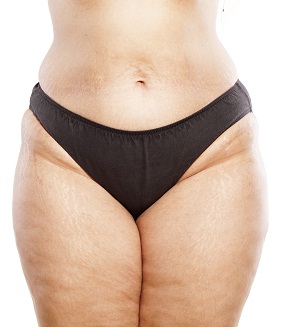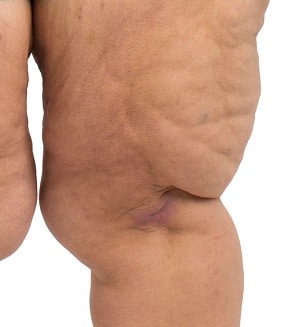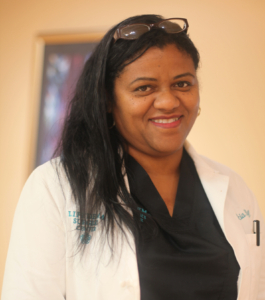Lipedema Diagnosis
Diagnosing lipedema begins with clinical history and in-person physical examination. Patients suffer from gross bilateral, symmetrical enlargement of the buttocks, thighs and calves — and occasionally the upper arms — but retain a relatively normal upper torso. The feet and hands are spared. Significantly, the areas of enlargement are often painful to palpation.
Dr. Marcia Byrd and Dr. Jovanni Blackmon, M.D. are considered experts in lipedema and its treatment. They specialize in lipedema and can provide the best options and education for managing this disease.
There are multiple factors to consider when making a lipedema diagnosis. In addition to the characteristic disproportionate fat accumulation, there are specific physical signs and symptoms of Lipedema.
- Bruise easily.
- Disproportionate fat accumulation, not affected by calorie restriction.
- Skin’s surface is uneven, with large bulges and valleys up and down.
- Skin’s surface feels nodular and firm, like beans in a bean bag or rubber balls.
- Tender skin that is sensitive to the touch.
- Swelling in the affected area.
What is Lipedema?

Lipedema is a congenital fat distribution disorder causing bilateral symmetrical adipose tissue to be disproportionately distributed in the lower extremities. Occurring almost exclusively in women, its onset is often preceded by hormonal shifts at puberty, childbirth and menopause.
First identified at the Mayo Clinic in 1940(1.), Lipedema is often misdiagnosed as bilateral lower extremity Lymphedema or simple obesity. The disease affects underweight and overweight women alike.
Presentation
Diagnosing Lipedema presents with one or more of these disease markers:





- Lower body disproportionately larger than upper body
- Adipose deposits unresponsive to diet or exercise
- Column-like appearance to legs
- Pain, tenderness upon touch
- Non-pitting edema in lower limbs
- Cuffing around ankles
- Vascular fragility
- Subcutaneous nodules
Patient of Dr. Marcia Byrd describes her experience of being diagnosed with Lipedema.
Prognosis
Lipedema liposuction is not a cosmetic procedure but is medically necessary for the cessation of this progressive disease. Without surgical intervention, knee and thigh circumference continues to increase causing gait changes and improper joint alignment resulting in joint degeneration, increased pain and reduced mobility and inability to exercise. Unchecked, Lipedema often results in chronic failure of lymphatic transportation system, fibrosis of the cutis and Lymphedema (2).
Surgical Methods for Treating Lipedema
Liposuction is the main surgical interventions for lipedema. Dr. Marcia Byrd and Dr. Jovanni Blackmon use their customized surgical method using tumescent liposuction combined with Water-Jet Assisted Liposuction (WAL), and Power-Assisted Liposuction (PAL). This lymph-sparing liposuction is performed under local anesthesia. Research reveals lymph-sparing liposuction yields good long-term results in reduction of Lipedema pain and halting disease progression(3).
Benefits of the WAL/PAL Procedure
- Rapid healing and wound recovery
- Local anesthesia
- Less pain and discomfort
- Little or no impact on surrounding tissue
- Reduced risk of complications in comparison with other liposuction methods
Patient Outcomes
Post-surgical results for WAL/PAL procedures performed by Dr. Marcia Byrd include reduction in pain, pressure sensitivity, edema, bruising, movement restrictions and cosmetic impairment (4). Post-operatively, patients may pursue active lifestyles with increased self-confidence and reduced pain.
In a recent survey these results were confirmed:
Positive Results
Overall, 84% of patients reported an improved quality of life, 86% reported improved or reduction in pain levels, and weight loss occurred across patients in all stages of Lipedema progression by the time they were 3-months post-surgery. While some patients experienced complications, such as growth of loose connective tissue
Overall, this study and survey found that women with lipedema noticed significant benefits after lipedema reduction surgery in the USA.
Survey Refrences:
Herbst, Karen & Hansen, Emily & Salinas, Leopoldo & Wright, Thomas & Larson, Ethan & Schwartz, Jaime. (2021). Survey Outcomes of Lipedema Reduction Surgery in the United States. Plastic and reconstructive surgery.
Marcia V. Byrd, MD

As the Medical Director and founder of the Lipedema Surgery Center, Dr. Marcia V. Byrd, MD has over twenty five years of experience in liposuction and body-sculpting techniques including lymph-sparing Water-Assisted Liposuction (WAL) and Power-Assisted Liposuction (PAL) techniques. She has performed over 10,000 successful Lipedema liposuction surgeries for women who travel from all over the United States, Canada and abroad.
She has trained with Dr. Josef Stutz of Germany, the world-renown authority on Lipedema liposuction. Internationally, she has apprenticed with some of the world’s leading aesthetic surgeons, including Dr. Giorgio Fischer, Rome, Italy, one of the creators of liposuction, Dr. Roger Amar of Marbella, Spain, who developed the FAMI procedure and Dr. Pierre Fournier of Paris, France, the father of aesthetic surgery.
Dr. Marcia V. Byrd, MD holds a medical degree from the University of South Alabama Medical College and trained in Obstetrics and Gynecology at the University of South Alabama Medical Center. As a long-time advocate for the Lipedema community, and a regular presenter at Fat Disorders Research Society (FDRS), she is passionately dedicated to treating Lipedema sufferers throughout the United States and abroad.
Jovannni Blackmon, MD
 Dr. Blackman received her bachelor of science degree from Harvard University. She earned her medical degree from Temple University School of Medicine and completed her residency at Mercer University in Macon, Georgia.
Dr. Blackman received her bachelor of science degree from Harvard University. She earned her medical degree from Temple University School of Medicine and completed her residency at Mercer University in Macon, Georgia.
Dr. Blackman is a licensed OB/GYN with 21 years of experience. Her specialties include minimally invasive surgery, an area in which she has received numerous awards. She served as a faculty member of Mercer University-Medical Center of Central Georgia before entering private practice.
She practiced privately in Pennsylvania 11 years before practicing abroad. Dr. Blackmon and her family have lived in several countries from South Africa to Jordan, being medical volunteers and doing mission-oriented work.
In 2024 Dr. Blackman joined Lipedema Surgery Center as a practice partner. Her education and surgical experience have made her a great addition to the team at Lipedema Surgery Center in Atlanta, GA.
References
1 Allen, E.V. E., and Hines, E. A., Jr. (1940): A syndrome characterized by fat legs and orthostatic edema. Proc Staff Meet Mayo Clinic 15, 184-187
3 Cornely et al., 2006; Schmeller et al., 2006; Warren et al., 2007; Stutz & Krahl, 2008; Rapprich et al., 2011, 2012
4 W. Schmeller, M.Hueppe & I. Meier-Vollrath, (2011): Tumescent liposuction in lipoedema yields good long-term results
Additional Resources
- Cornely, M. (2006). Lipedema and lymphatic edema. In Liposuction Principles and Practice (Shiffman, M. A., and Di Giuseppe, A., eds). Springer, Berlin Heidelberg.
- Rapprich, S., Dingler, A., & Podda, M. (2011). Liposuction is an effective treatment for lipedema-results of a study with 25 patients. doi:
10.1111/j.1610-0387.2010.07504. - Schmeller, W., Hueppe, M., & Meier-Vollrath, I. (2006). Tumescent liposuction in lipodema yields good long-term results. British Journal of Dermatology.
- Stutz, J. & Krahl, D. (2008). Water jet-assisted liposuction for patients with Lipoedema: Histologic and immunohistologic analysis of the aspirates of 30 Lipoedema patients.
- Springer Science + Business Media, LLC and International Society of Aesthetic Plastic Surgery, Mar; 33(2):153-62.
- Warren, A., Hakan, B., Borud, L., & Slavin, S. (2007). Lymphedema a comprehensive review. Ann Plast Surg 59(4): 464-472.
Call to Schedule a Consultation
Diagnosing lipedema begins with begins with a consultation with Marcia Byrd, M.D. either in person or on the phone. Call now to schedule 770-587-1711.


